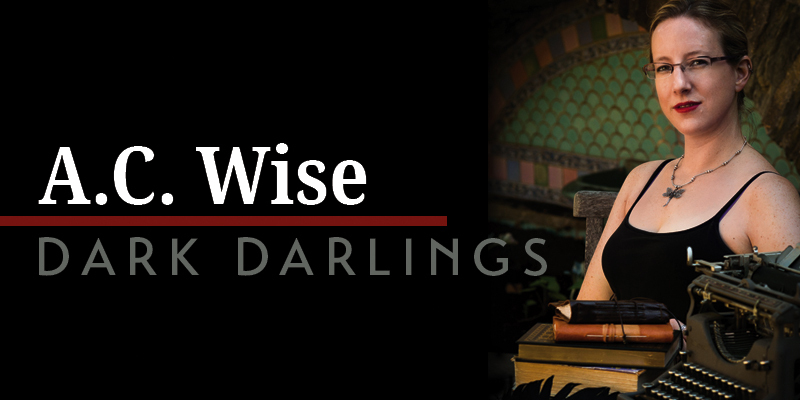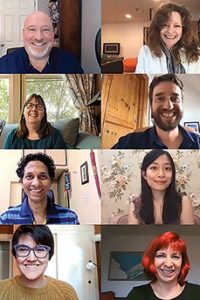A.C. Wise: Dark Darlings

Alison Campbell-Wise was born December 30, 1979 in Montreal, Canada. She moved to New Jersey 20 years ago with her husband, and they now live in the Philadelphia PA area.
She began publishing short fiction in 2005. Notable stories include Nebula Award finalists “How the Trick Is Done” (2019) and novella Catfish Lullaby, Sunburst Award winner “The Sailing of the Henry Charles Morgan in Six Pieces of Scrimshaw (1841)” (2016) and Sunburst finalists “The Men from Narrow Houses” (2016) and “The Time Traveler’s Husband” (2018). Some of her short fiction has been collected in The Ultra Fabulous Glitter Squadron Saves the World Again (2015), Lambda Award finalist The Kissing Booth Girl and Other Stories (2016), and the forthcoming The Ghost Sequences (2021).
She co-edited Unlikely Story with Bernie Mojzes from 2011-15, and is a reviewer for Apex and The Book Smugglers. She is currently a finalist for an Ignyte Award in the Critics Award category.
Wise’s debut novel Wendy, Darling, a dark feminist take on Peter Pan, is out June 2021, and a sequel is forthcoming.
Excerpts from the interview:
“I’ve never done any of the major workshops. I did a one-off workshop that lasted a couple of hours at my first-ever professional convention, in Montreal in 2009. That was my first experience with a professional workshop, and first experience with a professional con, which I must say was very overwhelming. I would not necessarily recommend Worldcon as somebody’s first con. I spent most of the time hiding in the corner and terrified by all the people, but it was still fun, and I liked it enough to keep up with some of the people that I met in that workshop. We transitioned to an online workshop that we ran for a couple years through LiveJournal, and through that I ended up meeting some people locally and doing some in-person workshops. I didn’t do any formal training for writing in school. I majored in history with a minor in religion, so that was all storytelling, but not for fiction writing exactly. It’s background stuff, and teaches you how to read narratives and think about narratives.
“I’ve always been a voracious reader, and probably always a voracious writer too. Some of the earliest stuff that really stuck with me were fairy tales, and the Chronicles of Narnia. At a certain point, I got really into Star Trek and started reading the novelizations and media tie-in work – that was probably one of my first forays into science fiction reading. Before that I had been more on the fantasy side of things. Shortly after that I discovered Ray Bradbury and became obsessed with his work, and fell in love with short stories. I was only into novels for a while and then, by reading his work, I realized, ‘Oh you can do interesting things with short stories.’ That’s about the time that I started trying to write stories again myself. Before that I was trying to write novels, and I have several terrible trunked teenage things that are absolutely terrifying and thankfully I’ve lost by now – there’s no chances of them ever seeing any light of day ever again.
“Writing is something I always enjoyed doing, but it took me a while to get to the point of figuring out how to professionally submit work. I tried sending stuff off when I was younger, with my mom helping me look up things, back in the day where you would go to a library and look at this giant book of publishers you could send work to. I would find places to submit and it was wildly off base. I had no idea what I was doing, but my mom was very supportive. She proofread my stuff and helped me mail things, and eventually I just learned by doing – which eventually led me here, many years later.
“I was very lucky in that my first short fiction sale was to a pro SFWA market, Story House Coffee. I still have the coffee can on my bookshelf. They used to print very short flash fiction on coffee can labels, which is pretty interesting. I don’t think they exist anymore, but it was a great idea. I love coffee, and I love fiction, so it seemed like an appropriate start. Even when I started in publishing, I still had no idea what I was doing. I hadn’t discovered professional conventions or workshops, and I didn’t really know where to find out how to do things. I was just trying to figure it out as I went along. There were a lot of ups and downs, submitting to markets that ended up folding, and at least one market completely screwed all its contributors over by disappearing and absconding with whatever money they were supposed to pay people. I didn’t know how to look for warning signs or reputable publishers, and I didn’t know where to aim myself or what to do. Eventually I did connect with other people writing genre and started to figure out where I could read about what the reputable markets were, what warning signs to look for, and what one should aspire to when they’re aspiring to professionalism. I resisted the idea of doing anything more than short stories for a long time. Even though I do have a novel coming out, I still find novels very intimidating and scary, and I’m not convinced I can write them. I had to trick myself into writing this one by starting with a flash fiction story, slowly expanding it from there to a novella, and then slowly expanding it from a novella to a novel, and never admitting to myself anywhere along the way that I was actually trying to write a novel. That’s how I was able to get it done – sneak up on the process and don’t tell myself what I’m doing, and maybe it’ll be okay. I still love short fiction, and I don’t intend to ever give up writing that either, even though I have moved into the novel territory now as well.
“I love reading my friends’ work and giving feedback and knowing that I have somebody who can read my stuff and tell me where I’ve gone wrong, or help me when I’m completely lost – or if I know, say, an ending isn’t working, but I don’t know why it isn’t working, or what to do to fix it. To have that other person come in with an outside perspective and go, ‘Oh, what if you did this?’, and then suddenly it all flows from there. All that, plus making friends and discovering new people to read and people to root for when I see their stories published or get award nominations. Most of the time the community is really fantastic, and people try to support each other and care about each other, and it’s nice to have other people who have that common language and common interest in terms of knowing what you’re going through when you get a story rejection, or celebrating with you when you get an acceptance, and helping you when you’re just banging your head against the wall and the words won’t come.
“As a reader, I love slow creeping horror and authors who have the talent of hinting at more than actually ends up on the page, where you get the sense of a larger world. That’s the part that digs into you, and that you find yourself thinking about later. Caitlín Kiernan is really good at doing that, and Paul Tremblay, and Livia Llewellyn, just to name a few people. That’s more appealing to me, both in terms of reading and the stuff I try to write, more than splatterpunk or really gory horror. I have nothing against that, and I’ll certainly read it, but I’m drawn to more psychological creeping horror – the sense that something is wrong here, or horror as a way to reflect people processing their own fears or traumas or things they’re worried about, and trying to get a handle on it. You can put those feelings in a safe box where you can read the story or novel and be done with it and put it away – that can be therapeutic.
“Sometimes it can be cathartic for me to write horror. Sometimes there’s a danger of trying to put too much in if I’m drawing on personal experience or something that’s annoying me at the moment. Like, if I tried to write some reflection of our current times and everything going on with the pandemic, it would get too bogged down in the personal. Sometimes I try to use my experiences that way, but I end up cutting out a lot of stuff that I put in, which I was just processing for myself.
“Sometimes I have to write a lot of wrong words to get to the right ones. I’m glad it looks okay from the outside, because it doesn’t feel that way when I’m doing it, most of the time. Right before this interview I was working on something for my collection that’s coming out later this year, which is mostly horror and ghost stories. I sent it off to the editor, and I thought it was fine. He said, ‘I just have a few minor edits for you,’ and when I looked at it again, I thought, ‘I hate this. I need a little bit of time with this. I’m going to make some changes.’ I thought I was just making a few changes, and I ended up ripping the story apart and stitching it back together again to the point where the core themes and characters are the same, and some of the events, but it’s going to be unrecognizable to the editor when he gets it back. That will be a surprise to him.”
Interview design by Stephen H. Segal. Photo by Steve Schultz.
Read the full interview in the June 2021 issue of Locus.
 While you are here, please take a moment to support Locus with a one-time or recurring donation. We rely on reader donations to keep the magazine and site going, and would like to keep the site paywall free, but WE NEED YOUR FINANCIAL SUPPORT to continue quality coverage of the science fiction and fantasy field.
While you are here, please take a moment to support Locus with a one-time or recurring donation. We rely on reader donations to keep the magazine and site going, and would like to keep the site paywall free, but WE NEED YOUR FINANCIAL SUPPORT to continue quality coverage of the science fiction and fantasy field.
©Locus Magazine. Copyrighted material may not be republished without permission of LSFF.







